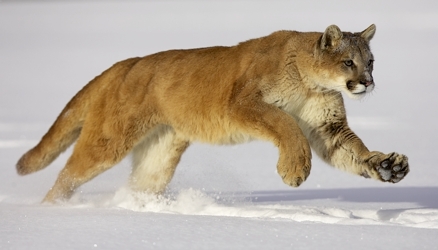 |
| THEY ARE STRONG. |
 |
| IT IS FOUND ON MOUNTAINS. |
The Puma is a solitary animal with the exception of the time cubs spend with their mother. Pumas patrol large home ranges in search of food which varies from 80 square miles in the summer to 40 in the winter, when the falling snow restricts access to a number of mountain areas. Some regions can become so hostile that Pumas migrate from the mountain forests and go down into the valleys to escape the worst of the cold. Not only can Pumas easily adapt to different surroundings but they are also able to hunt effectively during the day or night. Their strong and muscular hind legs and large paws mean that the Puma can move about amongst the rocks more quickly and with greater agility. Pumas are known to make a variety of different sounds particularly when warning another Puma away from their territory and during the mating season when they are looking for a mate.
 |
| PUMA CUB CLINGING TO A BRANCH OF A TREE. |
 |
| A DOG WITH PUMA CUBS.WHAT A BEAUTIFUL SCENERY. |
One of the most obvious reasons as to why this large and powerful feline is not classified as one of the world's 'big' Cats is that Pumas are not able to roar. This is something distinctive to the 'big' Cat family as no other feline is able to do so. The powerful hind legs of the Puma are so muscular that they not only allow them to pounce on and secure their prey, but they are also able to leap enormous distances of up to 20ft. One of the most famous subspecies of Puma is the Florida Panther which is the smallest of the Puma species and also the rarest. Thought to be on the brink of extinction, this endangered animal has more of a red tinge to the fur on it's back along with having a dark spot in the centre.

animalsbirds.com/stork-bird-images-hd-wallpapers/
ReplyDelete